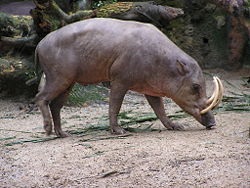- North Sulawesi babirusa
-
North Sulawesi Babirusa 
Adult male 
Conservation status Scientific classification Kingdom: Animalia Phylum: Chordata Class: Mammalia Order: Artiodactyla Family: Suidae Genus: Babyrousa Species: B. celebensis Binomial name Babyrousa celebensis
Deninger, 1909The North Sulawesi babirusa, Babyrousa celebensis, is a pig-like animal native to northern Sulawesi and the nearby Lembeh Islands in Indonesia. It has two pairs of large tusks composed of enlarged canine teeth. The canines in the maxilla penetrate the top of the snout, curving back toward the forehead. The North Sulawesi Babirusa is a threatened species.
The common and scientific names are various transcriptions of its local name, which quite literally means "pig-deer" (from Malay babi "pig" + rusa "deer" - see also Rusa Deer) in reference to the huge tusks of the male suggestive of a deer's antlers - and in fact used for a similar purpose.
Contents
Classification
Together with the other members of the genus Babyrousa, the North Sulawesi Babirusa has usually been considered a subspecies of a widespread Babyrousa babyrussa, but recent work suggests that there may be several species, differentiable on the basis of geography, body size, amount of body hair, and the shape of the upper canine tooth of the male. Following the split, the "true" Babyrousa babyrussa is restricted to Buru and the Sula Islands.
Most experts agree that babirusas are part of the pig family, and are one of the oldest living members of the family, representing a subfamily, Babyrousinae, that branched off from the warthog branch of the pig family (Subfamily Phacochoerini) during the Oligocene or early Miocene.
Habitat
Its habitat is the underbrush of tropical forests and canebrakes, and the shores of rivers and lakes. Its mostly-hairless, mottled-grey-and-brown hide provide it with a degree of camouflage. The North Sulawesi Babirusa is known for its two pairs of tusks; both its upper and its lower pairs of canine teeth are greatly enlarged, and curve up and back towards the head. The upper canines of the male Buru babirusa are so curved and enlarged that they emerge through the flesh, by way of holes, to pass through the top of the snout.
This species is protected by Indonesian law but is threatened by illegal hunting.[1]
Because it is split-hooved and has a three-chambered stomach (and was thus thought to be a ruminant for a long time), there was some dispute in Halakha (Jewish law) as to whether the babirusa is, in fact, kosher (permitted according to Jewish dietary laws). Eventually it was found that the animal is not a true ruminant, and thus remains trefe, like other pigs.
Captivity
In captivity, the species is very inbred. The Bronx Zoo has an excellent breeding record for this animal. There are not many zoos that have bred the animal; some that have are St. Louis Zoo, Los Angeles Zoo, South Lakes Wild Animal Park, Marwell Wildlife, and Chester Zoo.
In 2006, a male North Sulawesi Babirusa and a female domestic pig were accidentally allowed to interbreed in the Copenhagen Zoo. The offspring were 5 hybrid piglets with teeth most resembling the North Sulawesi Babirusa, while their colour was highly variable.[2]
Media
-
Video of the Babyrousa celebensis at Disney's Animal Kingdom
-
Male and female Babirusa at Edinburgh Zoo
-
Babirusas sleeping at Singapore Zoo
References
- ^ Clayton, L. M.. "Effects of a Proposed Ex situ Conservation Program on In situ Conservation of the Babirusa, an Endangered Suid" Conservation Biology 14. 2 (2000), 382-385.
- ^ http://denmark.dk/portal/page?_pageid=374,610590&_dad=portal&_schema=PORTAL&ic_itemid=929035[dead link]
- Leus, K. & Oliver, W. (2008). Babyrousa celebensis. In: IUCN 2008. IUCN Red List of Threatened Species. Downloaded on 15 November 2008. Listed as Vulnerable ( A2cd; C1)
External links
- ARKive - images and movies of the babirusas (Babyrousa spp)
- Short narrated video about the Babirusa
- http://www.thebigzoo.com/Animals/Babirusa.asp
- http://darrennaish.blogspot.com/2006/08/many-babirusa-species-laissez-faire.html
- http://www.ylm.se/default.asp?s=3d/
- http://www.rufford.org/rsg/Projects/LynnClayton
- http://www.whitleyaward.org/display.php?id=84
- http://news.bbc.co.uk/1/hi/sci/tech/3493161.stm
- http://earth-info-net-babirusa.blogspot.com/
- http://www.thejakartapost.com/weekender/5profile.asp
Categories:- IUCN Red List vulnerable species
- Pigs
- Mammals of Indonesia
- Animals described in 1909
-
Wikimedia Foundation. 2010.



